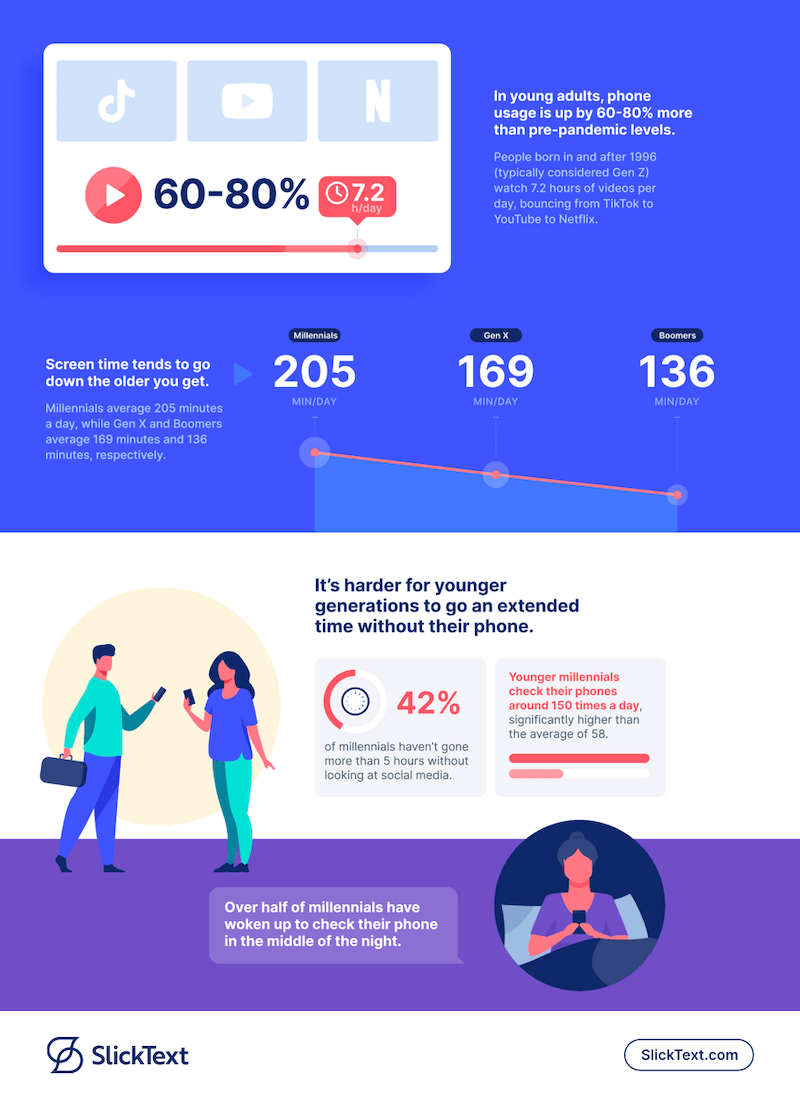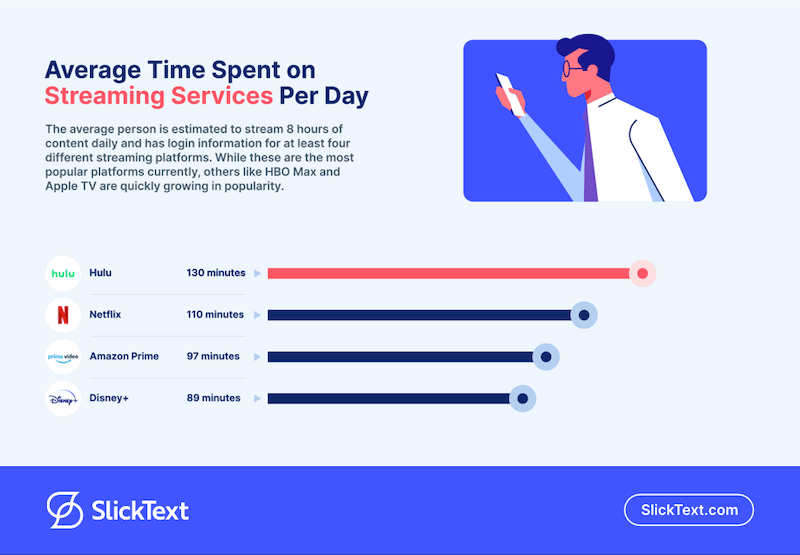30+ Average Screen Time Statistics for 2024
Updated March 6th, 2025
Since the COVID-19 pandemic made phones and laptops a necessary part of working, learning, and living, screen time has skyrocketed — and Apple’s weekly screen time notification has made that all the more apparent.
Now that life has more or less returned to the status quo, though, are people still relying on their phones, laptops, and TVs as much as they used to?
Here are the latest statistics on average screen time and how screen habits have changed over the past few years, plus, some signs that’ll help you figure out if you’re spending too much time on your phone — brought to you by SlickText.
Average Screen Time By Age

Screens are more ubiquitous than ever, and the average screen times by age prove that. Recommendations for screen time are around 2 hours for kids ages 6-17 and 2-4 hours a day for adults ages 18 and over (outside of work). In reality, the actual average screen time for teens and children are much higher.
- 40% of children consistently use a digital table by the age of 2.
- 25% of children own a personal cellphone by the age of 8.
- For children 8 and under, gaming has increased by 65% over the last 4 years.
- On average, children 8-18 spend 7.5 hours a day in front of screens for entertainment alone — which amounts to 114 days a year.
- To break that down further, children ages 0-8 spend around 2.5 hours per day and ages 8-10 spend around 6 hours per day in front of a screen. That number increases with age, as children 11-14 spend about 9 hours a day on screens, and teenagers 15-18 have an average screen time of 7.5 hours.
- Even though the American Academy of Pediatrics recommends limiting screen time to two hours per day for kids 10 and under, the stats above show most households are allowing far more screen time than experts advise.

Average Screen Time for Young Adults
- In young adults, phone usage is up by 60-80% compared to pre-pandemic levels. People born in and after 1996 (typically considered Gen Z) watch 7.2 hours of videos per day, bouncing from TikTok to YouTube to Netflix.
- Average screen time tends to go down the older you get. Millennials average 205 minutes a day, while Gen X and Boomers average 169 minutes and 136 minutes, respectively.
- It’s harder for younger generations to go an extended time without their phone. 42% of millennials haven’t gone more than 5 hours without looking at social media, and younger millennials check their phones around 150 times a day, significantly higher than the average of 58.
- Over half of millennials have woken up to check their phone in the middle of the night.
 Average Screen Time for Boomers, Gen X, Millennials, and Gen Z
Average Screen Time for Boomers, Gen X, Millennials, and Gen Z
The most popular internet activities based on age groups are:
- Boomers: online searches and banking
- Gen X: social media and online searches
- Millennials: social media and streaming
- Amazon, Google, and Facebook are the three most popular sites for Boomers, Gen Xers, and Millennials.
- While Gen Z is one of the worst screen-time offenders, they’re also the most self-aware. 76% of Gen Zers say they spend too much time on their phone, followed by 67% of Millennials, 66% of Gen Xers, and 51% of Boomers.
COVID and Phone Screen Time Statistics

With the shift to working and schooling from home, adults and children had no choice but to spend more time in front of screens. Not all of that screen time is considered negative, however, as some of it was used for things like virtual social gatherings and spending time with family.
Still, a few years after the onset of the pandemic, that heightened average screen time is lingering longer than many people may have anticipated.
- Since the pandemic, kids in the United States use electronic devices twice as much as before.
- During the height of COVID-19, 62% of U.S. parents reported that their kids and teens were spending more than 4 hours a day in front of a screen, with Netflix and YouTube being the most popular apps.
- When it comes to staying connected during COVID, teens far preferred texting to calling. 83% of teens used texting to stay in touch, 72% used phone calls, and 37% used email.
- Findings indicate that internet usage increased by 50-70% since the pandemic started.
- Increased time on screens gave rise to more negative emotions like anxiousness, depression, and irritability.
- It’s not just emotional states that have suffered as a result of increased screen time — it’s also caused damage to eating habits, sleep habits, and optical health, as well as headaches, neck pain, and high blood pressure.
Average Screen Time Trends: The Most Popular Apps and Digital Activities

- Gen Z spends about half of their screen time on user-created content on TikTok and YouTube. This varies greatly from Gen X, who spend around ¾ of their time on professionally produced content.
- Streaming services are struggling to fight subscriber drain, but Deloitte found that one-fourth of people from the US who canceled a subscription returned to that service within 12 months. This was especially true for Gen Z.
- In the United States, the top three most popular social media activities were reading/watching the news, listening to music, and watching TV/movies. Again, Gen Z was an outlier, identifying video games as the most popular activity.
- Gen Z and Millennial gamers spend 11-13 hours on gameplay per week.
- Some of the most popular reasons for gaming include relaxation, self-expression, and distraction during difficult times.
- Gaming provides the opportunity to multitask. Around half of all video game players in the US also listen to new music while playing.
- In 2024, TikTok was king among apps, with the most downloads reported worldwide, followed by Instagram, Facebook, WhatsApp, and Telegram.
- Worldwide, the most downloaded apps in 2024 were:
- TikTok: 825 million downloads
- Instagram: 817 million downloads
- Facebook: 598 million downloads
- WhatsApp: 564 million downloads
- Temu: 448 million downloads
- CapCut: 410 million downloads
- Snapchat: 330 million downloads
- Threads: 327 million downloads
- WhatsApp Business: 294 millions downloads
- Facebook Messenger: 289 million downloads
- ChatGPT: 282 million downloads
- Spotify: 244 million downloads
- Shein: 228 million downloads
- Roblox: 201 million downloads
- When it comes to shopping online, the most popular sites in the US include:
- Amazon
- Walmart
- Target
- eBay
- Apple
- Best Buy
Average Time Spent on Social Media Apps Per Day

In 2024, it’s estimated that the average person spends 143 minutes on social media each day, up two minutes from 2021’s average.
- TikTok: 67 minutes
- YouTube: 55 minutes
- Twitter: 9 minutes
- Snapchat: 7 minutes
- Facebook: 39 minutes
- Instagram: 31 minutes
Average Time Spent on Streaming Services Per Day

The average person is estimated to stream 3 hours of content daily and 95% of viewers have login information for at least two different streaming platforms.
According to Nielson, Disney+ claims credit for the most watched and top acquired show of the year—Bluey—with 55.62 billion minutes streamed. The most watched original series was Bridgerton, streaming on Netflix for 21 billion minutes. The top streaming movie was Moana, with 13.03 billion minutes viewed on Disney+.
Best User Experience According to Viewers
- Netflix: 36%
- Amazon Prime Video: 14%
- ESPN+: 11%
- Disney+: 9%
- Max (previously called HBO Max): 7%
Signs of Excessive Screen Time
While not all screen time is bad, too much time in front of screens can have negative impacts on your social, physical, and emotional well-being. Here are some signs that it might be time to put down your phone.
- Poor sleep: Blue light exposure from screens can suppress melatonin, which is the hormone that helps regulate your sleep. When you use your phone close to bedtime, your body produces less melatonin, making it harder to sleep. A lack of proper rest can result in other health issues such as mental fog, an inability to focus, memory issues, mood swings, and lower energy levels.
- Vision impairment: You might find yourself squinting or straining when you stare at a screen for too long. The continued exposure to light and focus on something so close to your face can cause headaches, ocular sensitivity, dryness, blurred vision, and more. There’s even a chance for long-term vision damage, known as myopia.
- Chronic pain: Angling your head and neck to stare at a phone, computer, or TV can encourage poor posture. As a result, you might deal with recurring pain in your neck, back, and shoulders.
- Weight gain: Activities associated with screen time are almost always sedentary. Spending too much time sitting or laying can lead to weight gain, which can also cause diabetes, heart issues, and increased blood pressure.
- Poor mental health: Watching TV, playing video games, or browsing social media might feel good in the short term, but in the long term, it’s shown to cause higher levels of anxiety and depression and lower levels of social awareness.
By limiting your screen time to the recommended two hours per day, you can avoid some of the negative consequences associated with excessive use.
Sources:
AACAP
PC Mag
Elite Content Marketer
Statista I, II
Frontiers
Los Angeles Times
Deloitte
Business of Apps
Oberlo
Deadline
Indie Wire
Valleywise Health
DataReportal
Nielson